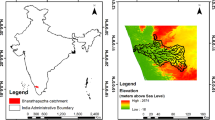Summary
Attempts to use the 4-parameter Kappa distribution (K4D) with the maximum likelihood estimates (MLE) on the summer extreme daily rainfall data at 61 gauging stations over South Korea have been made to obtain reliable quantile estimates for several return periods. A numerical algorithm for searching MLE of K4D by minimizing the negative log-likelihood function with penalty method has been described. The isopluvial maps of estimated design values corresponding to selected return periods have been presented. The highest return values are centered at sites in the south-western part of the Korean peninsula. The distribution of return values for annual maxima of 2-day precipitation (AMP2) is more similar to the climatological features of annual total precipitation of Korea than that of annual maxima of daily precipitation (AMP1). Our results of return values delineate well the horizontal patterns of the heavy precipitation over the Korean peninsula.
Similar content being viewed by others
Author information
Authors and Affiliations
Additional information
Received January 15, 2001 Revised October 8, 2001
Rights and permissions
About this article
Cite this article
Park, JS., Jung, HS. Modelling Korean extreme rainfall using a Kappa distribution and maximum likelihood estimate. Theor Appl Climatol 72, 55–64 (2002). https://doi.org/10.1007/s007040200012
Issue Date:
DOI: https://doi.org/10.1007/s007040200012




